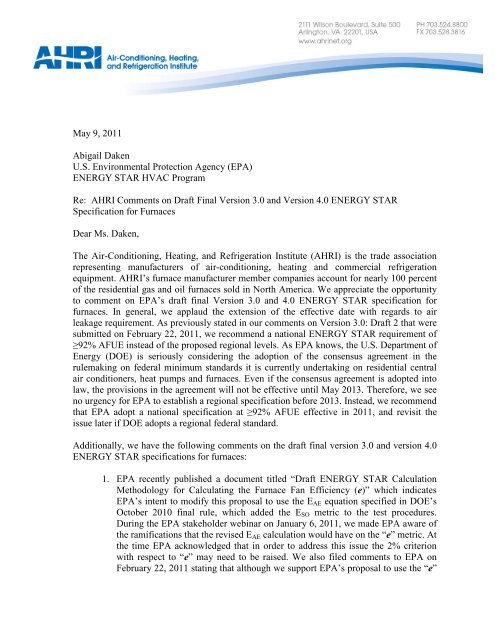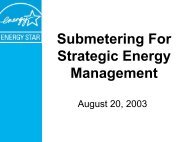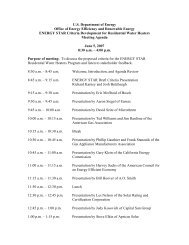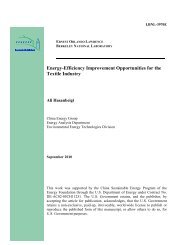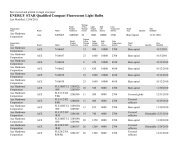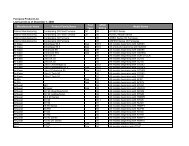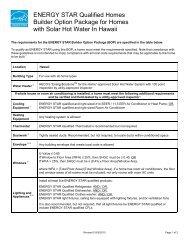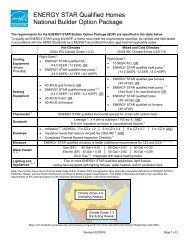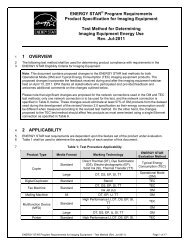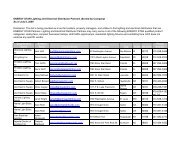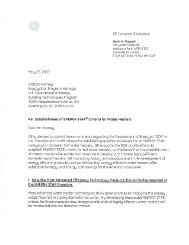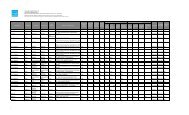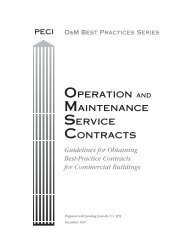AHRI Comments - Energy Star
AHRI Comments - Energy Star
AHRI Comments - Energy Star
You also want an ePaper? Increase the reach of your titles
YUMPU automatically turns print PDFs into web optimized ePapers that Google loves.
May 9, 2011<br />
Abigail Daken<br />
U.S. Environmental Protection Agency (EPA)<br />
ENERGY STAR HVAC Program<br />
Re: <strong>AHRI</strong> <strong>Comments</strong> on Draft Final Version 3.0 and Version 4.0 ENERGY STAR<br />
Specification for Furnaces<br />
Dear Ms. Daken,<br />
The Air-Conditioning, Heating, and Refrigeration Institute (<strong>AHRI</strong>) is the trade association<br />
representing manufacturers of air-conditioning, heating and commercial refrigeration<br />
equipment. <strong>AHRI</strong>’s furnace manufacturer member companies account for nearly 100 percent<br />
of the residential gas and oil furnaces sold in North America. We appreciate the opportunity<br />
to comment on EPA’s draft final Version 3.0 and 4.0 ENERGY STAR specification for<br />
furnaces. In general, we applaud the extension of the effective date with regards to air<br />
leakage requirement. As previously stated in our comments on Version 3.0: Draft 2 that were<br />
submitted on February 22, 2011, we recommend a national ENERGY STAR requirement of<br />
≥92% AFUE instead of the proposed regional levels. As EPA knows, the U.S. Department of<br />
<strong>Energy</strong> (DOE) is seriously considering the adoption of the consensus agreement in the<br />
rulemaking on federal minimum standards it is currently undertaking on residential central<br />
air conditioners, heat pumps and furnaces. Even if the consensus agreement is adopted into<br />
law, the provisions in the agreement will not be effective until May 2013. Therefore, we see<br />
no urgency for EPA to establish a regional specification before 2013. Instead, we recommend<br />
that EPA adopt a national specification at ≥92% AFUE effective in 2011, and revisit the<br />
issue later if DOE adopts a regional federal standard.<br />
Additionally, we have the following comments on the draft final version 3.0 and version 4.0<br />
ENERGY STAR specifications for furnaces:<br />
1. EPA recently published a document titled “Draft ENERGY STAR Calculation<br />
Methodology for Calculating the Furnace Fan Efficiency (e)” which indicates<br />
EPA’s intent to modify this proposal to use the EAE equation specified in DOE’s<br />
October 2010 final rule, which added the ESO metric to the test procedures.<br />
During the EPA stakeholder webinar on January 6, 2011, we made EPA aware of<br />
the ramifications that the revised EAE calculation would have on the “e” metric. At<br />
the time EPA acknowledged that in order to address this issue the 2% criterion<br />
with respect to “e” may need to be raised. We also filed comments to EPA on<br />
February 22, 2011 stating that although we support EPA’s proposal to use the “e”
2 | Page<br />
metric and the established 2% criterion, a redefinition of the “e” calculation is<br />
now required in order to maintain the same level of stringency. This is due to the<br />
fact that DOE revised the EAE calculation in its October 2010 final rule. The<br />
current EPA draft defines the calculation for “e” as it was originally developed<br />
and is used in incentive programs and federal tax credit legislation. The scope of<br />
EPA’s calculation methodology document states that the test approach duplicates<br />
that stipulated in EISA 2007. As currently written, the Version 3.0 and 4.0<br />
specification is not consistent with the criterion for furnace fans in EISA 2007.<br />
On October 20, 2010 DOE issued a Final Rule to add a test procedure and<br />
calculation to determine the energy consumption during standby and off modes<br />
(ESO) for residential furnaces and boilers. The Final Rule also redefined EAE to<br />
add the ESO term to the calculation for that metric. The revised calculation is:<br />
This revised EAE calculation inadvertently changes the “e” metric. If this revised<br />
EAE value were used in the “e” calculation, higher “e” values would result for all<br />
models. Many existing furnaces that currently meet the 2% criterion would<br />
exceed the criterion, and be disqualified from various federal and state tax<br />
incentives associated with the advanced main air circulating fan. To rectify this<br />
situation and continue to maintain the original criterion for “e”, <strong>AHRI</strong><br />
recommends that EPA use the following revised “e” metric in its specification:<br />
[(EAE - ESO) x 3413]/[((EAE - ESO) x 3413) + (Ef x 1,000,000)] ≤ 2%<br />
Furnaces currently meeting the ≤2% criterion for “e” must continue to be<br />
recognized as such. The characteristics that made such furnaces qualify for “e”<br />
remain the same and the recognition of those models should not be arbitrarily<br />
changed by a test procedure revision that does not directly relate to the “e” metric.<br />
If EPA is against the approach of using the revised “e” metric in the furnace<br />
specification, EPA should clarify that this proposal is an increase in the stringency<br />
of this furnace fan efficiency specification. Unless the “e” calculation is revised or<br />
the 2% criterion is raised, the specification would automatically disqualify 43% of<br />
the furnaces on the <strong>AHRI</strong> directory that have a minimum AFUE rating of 90%<br />
and meet the 2% criterion. Increasing the 2% criterion may cause further<br />
confusion in the marketplace since it currently exists in legislation and various<br />
incentive programs. Making changes to the 2% criterion in legislation would be<br />
an uncertain and laborious process. Furthermore, when the industry established<br />
the “e” metric in 2003, the 2% criterion was found to be an adequate benchmark<br />
to distinguish electrically efficient furnaces. Therefore, we suggest that EPA<br />
adopt the revised “e” metric in its furnace specification.<br />
2. Although Section 5A, line 224 of the furnace specification mentions the term<br />
“Basic Model”, there is no reference to this term in Section 1. We think that<br />
EPA’s intent was to reference “Product Family”. Additionally, we feel that “Basic<br />
Model Group” is a more appropriate term than “Product Family”.
3 | Page<br />
3. The definition of AFUE in the furnace specification should be consistent with the<br />
definition in Section 10.1 of Appendix N to Subpart B of Part 430 in the Code of<br />
Federal Regulations.<br />
4. The definition of “e” in lines 40-43 of the furnace specification needs to be<br />
revised to indicate that “e” is the ratio of the furnace electrical consumption to the<br />
total energy consumption of the furnace during the heating mode. We want to<br />
reiterate that EPA should revise the “e” calculation in order to avoid disqualifying<br />
products that currently meet the “e” criterion (refer to comment #1).<br />
5. Section 3D in the furnace specification is unclear and should be revised. Line 194<br />
indicates that the manufacturer shall not benefit from rounding, but line 197<br />
indicates that reported results shall be rounded to the nearest significant digit. As<br />
an example of how ambiguous this section is, a manufacturer producing a 95.6%<br />
AFUE furnace would be required to round it to 95%. As the EPA continues to<br />
increase the AFUE minimums in its ENERGY STAR specifications with respect<br />
to furnaces (including the top tier program), rounding requirements such as those<br />
specified in section 3D create a significant disadvantage for manufacturers in the<br />
marketplace. Instead, EPA should revise the significant digits for the criteria in<br />
Table 1 as follows:<br />
Product<br />
Type<br />
Gas<br />
Furnace<br />
Oil<br />
Furnace<br />
Regions AFUE Furnace Fan<br />
Efficiency (e )<br />
U.S.<br />
North/Canada<br />
≥ 95.0%<br />
U.S. South ≥ 90.0%<br />
U.S. (all)/Canada ≥ 85.0%<br />
≤ 2.0%<br />
Air<br />
Leakage<br />
(Qleak)<br />
≤ 2.0%<br />
6. The ENERGY STAR requirement in Table 2 should exclude EAE and EF since<br />
there are no requirements associated with these metrics in the furnace<br />
specification.<br />
7. The industry is currently evaluating an appropriate tolerance with respect to<br />
verification testing of “e”. We intend to file comments on this issue shortly.<br />
Additionally, the industry may file comments in the future with respect to the<br />
significant digits and the appropriate tolerance for cabinet air leakage in Table 1,<br />
Version 4.0.<br />
In summary, <strong>AHRI</strong> feels that the furnace specification has some serious flaws that would<br />
negatively impact the participants within ENERGY STAR program, despite the fact that<br />
some of them manufacturer products that meet the criteria in the specification. We would<br />
appreciate an opportunity to discuss this specification further with EPA. If you have any<br />
questions or wish to discuss this further, please do not hesitate to call me at (703) 600-0383.<br />
Sincerely,
Aniruddh Roy<br />
Regulatory Engineer<br />
Air-Conditioning, Heating, and Refrigeration Institute<br />
2111 Wilson Boulevard, Suite 500<br />
Arlington, VA 22201-3001, USA<br />
703-600-0383 Phone<br />
703-562-1942 Fax<br />
aroy@ahrinet.org<br />
4 | Page


